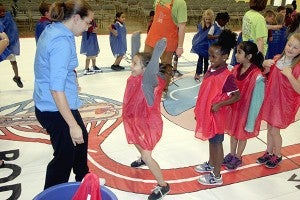Nicholson Elementary’s Science Day
Published 7:00 am Friday, May 23, 2014

CARRYING OXYGEN: Children pretend to be red and blue blood cells to learn about the circulatory system.
Photo by Jeremy Pittari
Geography, functions of the human circulatory system and 3D printing were all featured at Nicholson Elementary’s Science Day.
Children at the school had the opportunity to learn all about the three topics during Thursday’s event.
In the cafeteria, children were presented with information on how altitude affects climate by Joyce Youngblood with the Geography Alliance. During the exercise she demonstrated how different parts of the country have varying climates based on their rainfall and temperature and how altitude plays a part.
In the school’s new multipurpose building, Collin Hughes and Lacey Andrews, who are with the Mississippi Children’s Museum in Jackson, shared information about staying healthy through diet and exercise and how the heart, lungs and blood forms the circulatory system.
Their presentation got the children involved by having them separate foods into the four basic groups of fruits, vegetables, meats and grains.
Then Hughes taught the children about the circulatory system by having them dress in red and blue smocks, representing blood cells that contain and don’t contain oxygen respectively. The children were then asked to walk on a floor diagram of the heart, blood vessels and lungs.
“The best way to understand it is to be a part of it,” Andrews said.
After the children passed through the lungs, they changed their blue smocks to red smocks, and once they exhausted their oxygen within the body, they changed back into blue smocks.
“Blood cells are basically like the mailman, they bring it to whatever part of the body needs oxygen,” Hughes said to the children.
Andrews said, so far, Nicholson Elementary is the first school to see the presentation; but they plan to spread the word of living a healthy lifestyle by sharing it with every school in the state.
Emotional health was also covered in the presentation.
The third part of Science Day was a demonstration and presentation on 3D printers. Nicholson Elementary gifted teacher Maureen Pollitz said the printer on display belongs to the high school’s robotics team, Team CHAOS. Pollitz said she was able to procure the pre-assembled printer through a For Inspiration of Science and Technology lottery, at no cost to the school.
Nicholson Elementary Librarian Michelle Carter began printing a small object she said would take about 20 minutes. While the children waited on that, she showed them a few videos of 3D printing’s capabilities and advancements. The videos covered the typical creation of objects using metal, plastic and rubber, but also added that new technology is working towards the printing of body parts using specialized biodegradable materials. So far, body parts such as ears, noses, skin and even kidneys capable of surviving a few months have been printed, though not with the type of printer the school has on hand.
More advanced printers have the capability of producing an entire object complete with moving parts, such as a crescent wrench, without the need to put it together. The process uses specialized material that resembles sand, and can employ resins to create harder substances. Potential applications could include manufacturing objects in space, such as tools.
Also under development is the printing of food items.




